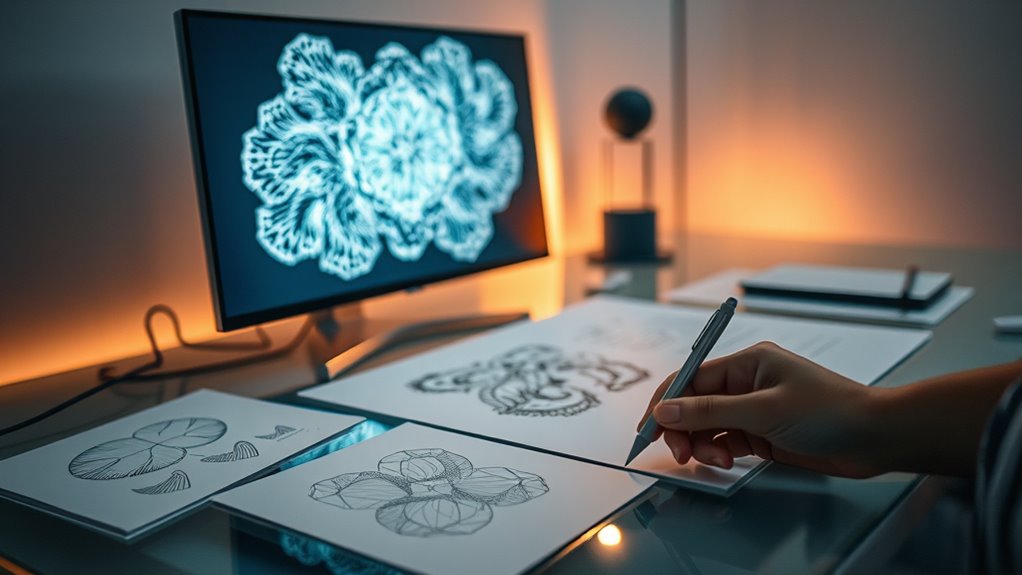When you consider ethical aspects of AI-generated design, focus on fairness, transparency, and respect for cultural diversity. Be aware that biases in training data can reinforce stereotypes, so continuous checks and diverse sources are essential. Clarify ownership and authorship rights to prevent disputes, and explain how algorithms work to build trust. Address potential harm and promote inclusivity, ensuring ethical standards guide your process. Exploring these aspects will deepen your understanding of responsible AI use.
Key Takeaways
- Address biases in training data to prevent reinforcement of stereotypes and ensure fair, diverse representations in AI-generated designs.
- Promote transparency by clearly explaining AI algorithms, decision-making processes, and data usage to foster trust and accountability.
- Consider societal and cultural impacts of AI designs to avoid unintended harm and promote inclusivity and cultural sensitivity.
- Clarify authorship, ownership, and legal rights of AI-generated works to ensure ethical use and protect intellectual property.
- Implement ongoing bias detection, regular audits, and user feedback mechanisms to uphold ethical standards and improve fairness over time.
Understanding the Origins of AI-Generated Designs

Understanding where AI-generated designs come from requires examining the underlying technologies and data that shape them. Historical influences play a significant role, as AI models often learn from past art, design trends, and cultural milestones. These influences can shape the aesthetic choices and patterns the AI produces, reflecting society’s evolving tastes. Cultural implications are equally important, because biases and norms embedded in training data can influence the outputs, potentially reinforcing stereotypes or overlooking diverse perspectives. By understanding these origins, you can better appreciate how AI designs mirror human history and culture, highlighting both the creative potential and ethical challenges. Recognizing these factors helps you critically evaluate AI-generated work and consider its broader societal impact. Additionally, awareness of training data sources is essential, as they directly impact the diversity and fairness of AI-generated designs. Moreover, understanding the cultural context in which AI models are developed can help identify potential biases and areas for improvement. Exploring the ethical considerations associated with data collection and model training further ensures responsible AI use and design integrity. It is also important to consider how algorithmic bias can influence outcomes and the importance of ongoing efforts to mitigate such biases for more equitable designs.
Ensuring Fairness and Avoiding Bias in AI Tools

You need to recognize where biases might originate in AI tools, whether from training data or algorithm design. By identifying these sources, you can take steps to promote more equitable algorithms. Ensuring fairness requires ongoing attention and deliberate efforts to minimize unintended bias. Considering high-quality training data is essential for developing accurate and fair AI systems. Additionally, understanding the sources of bias in data collection can help mitigate disparities in AI outcomes, and implementing regular bias assessments can further improve fairness over time.
Identifying Bias Sources
How can we effectively identify bias sources in AI-generated design tools? The key lies in establishing strong algorithmic accountability. By scrutinizing data inputs, training processes, and decision-making pathways, you can uncover hidden biases. Focus on cultural bias mitigation by evaluating whether the AI reflects diverse cultural perspectives or inadvertently favors certain groups. Regular audits and transparency in model development help pinpoint where bias may originate. Also, involve diverse teams to challenge assumptions and recognize potential blind spots. Understanding the sources of bias allows you to address them early, ensuring fairer outputs. Additionally, staying informed about best practices in curation and recommendation and diverse team involvement can help maintain high-quality and balanced AI outputs. Incorporating ongoing bias detection techniques enhances the ability to spot and correct biases as they emerge. For instance, utilizing diverse training data can significantly reduce the risk of biased outcomes. Moreover, implementing continuous monitoring of AI outputs can help identify biases that develop over time. Ultimately, identifying bias sources is an ongoing process that requires vigilance, openness, and a commitment to fairness in AI design.
Promoting Equitable Algorithms
Promoting equitable algorithms requires actively designing AI systems that prioritize fairness and prevent bias from influencing outcomes. To achieve this, focus on bias mitigation strategies and ensure algorithmic accountability throughout development. You should regularly audit algorithms for biased patterns and adjust data inputs accordingly. Incorporating diverse data sources helps reduce unfair disparities and enhances fairness. Transparency in decision-making processes fosters trust and accountability. Here’s a visual guide:
| Strategy | Implementation | Expected Outcome |
|---|---|---|
| Bias mitigation | Diverse training data | Fairer results |
| Regular audits | Bias detection tools | Increased accountability |
| Transparent design | Clear explanation of models | Trust enhancement |
| Inclusive data use | Avoiding data exclusion biases | Equitable outcomes |
| Algorithm updates | Continuous improvement efforts | Sustained fairness |
Additionally, understanding that creativity can be cultivated by anyone, regardless of skill level, emphasizes the importance of ongoing learning and adaptation in developing more equitable AI systems. Incorporating diverse data sources, which can help address existing biases, also encourages inclusive innovation and inclusivity in AI development. Recognizing the influence of cultural narratives in data can further improve fairness and representation in AI outputs. Furthermore, fostering algorithmic transparency ensures stakeholders can better understand and trust AI decision-making processes.
Clarifying Authorship and Ownership Rights

You need to understand who holds creative ownership when AI contributes to a design. Clarifying intellectual property rights can be complex, especially when defining authorship standards. Addressing these issues upfront helps prevent disputes and guarantees fair recognition for all contributors. Incorporating principles of ethical sound design digital literacy and critical thinking skills ensures responsible use of AI in creative processes. Additionally, understanding the power of electric dirt bikes of involved parties can facilitate clearer communication and agreement on ownership rights.
Defining Creative Ownership
Determining who owns the rights to AI-generated designs is a complex issue that hinges on clarifying authorship. When AI creates a design, it challenges traditional notions of creative sovereignty, prompting you to contemplate whether ownership lies with the developer, user, or the AI itself. Collaborative licensing models can help clarify rights, allowing multiple parties to share ownership or usage rights transparently. This approach respects the contributions of both human and machine, ensuring that creators retain some control while acknowledging AI’s role. By establishing clear agreements on ownership, you avoid ambiguities and promote ethical use of AI tools. Additionally, understanding the cultural significance of AI in art can foster more ethically mindful practices and respectful integration of technology into creative fields. Recognizing the importance of local legal resources and knowledgeable attorneys can also support creators in navigating these complex rights issues. Considering intellectual property laws related to AI-generated work is crucial to prevent potential disputes and ensure fair recognition. As AI continues to evolve, AI security measures are essential to protect creative outputs from unauthorized use and manipulation. Ultimately, defining creative ownership requires balancing innovation with responsibility, recognizing that the human element remains central in guiding AI’s creative output.
Intellectual Property Challenges
Clarifying who holds rights to AI-generated designs is one of the most pressing intellectual property challenges today. Licensing complexities make it difficult to determine how rights are shared or transferred, especially when multiple parties contribute to the AI’s output. You may face issues establishing clear agreements on usage and royalties. Patent ambiguities also pose problems; it’s often unclear whether AI-created inventions qualify for patent protection or if humans must be credited as inventors. These uncertainties can hinder innovation and lead to legal disputes. As AI continues to evolve, you need to navigate these challenges carefully, ensuring rights are properly defined and protected. Clarifying ownership rights helps prevent conflicts and promotes responsible, ethical use of AI-generated creations.
Authorship Attribution Standards
How do we establish clear authorship and ownership rights when AI contributes to creative works? Determining authorship involves clarifying whether humans, AI, or both hold moral responsibility. Collaborative authorship recognizes shared contributions, but assigning ownership rights requires transparency about each participant’s role. To help you understand, here’s a quick overview:
| Contributor | Role |
|---|---|
| Human creator | Initiates, guides, owns |
| AI system | Assists, generates output |
| Moral responsibility | Shared or assigned based on input and control |
| Ownership rights | Based on contribution and agreements |
This table emphasizes the importance of defining roles clearly, ensuring moral responsibility and ownership are fairly attributed in AI-assisted projects.
Promoting Transparency in AI Design Processes

Promoting transparency in AI design processes is essential for building trust and accountability. You should clearly explain how algorithms work, ensuring users understand the decision-making logic. This promotes algorithm accountability, making it easier to identify and address biases or errors. Additionally, obtaining user consent is crucial; users need to know what data is collected and how it’s used. Transparency isn’t just about sharing technical details but also about communicating intentions and limitations clearly. When you prioritize openness, you foster confidence in your AI systems and support ethical standards. Ultimately, transparent processes help users make informed choices and hold developers accountable, creating a responsible environment for AI-generated designs.
Addressing Potential for Unintended Harm and Discrimination

While AI-generated designs offer innovative possibilities, they also carry the risk of causing unintended harm or perpetuating discrimination if not carefully managed. To prevent this, you must actively identify potential unintended consequences and implement discrimination mitigation strategies. Recognizing biases in training data is vital to reduce discrimination risks, but it’s not enough. Regularly auditing AI outputs helps catch issues early. Here’s a quick overview:
| Step | Action | Goal |
|---|---|---|
| Data review | Check for bias | Minimize discrimination |
| Model testing | Evaluate outputs | Detect unintended consequences |
| User feedback | Gather insights | Improve fairness and safety |
| Continuous monitoring | Track performance | Maintain ethical standards |
| Transparency | Share findings | Build trust and accountability |
Fostering Inclusivity and Diversity in AI-Driven Creativity

Building on efforts to identify and mitigate biases, fostering inclusivity and diversity in AI-driven creativity guarantees that generated designs reflect a broad range of perspectives and experiences. You play a vital role in ensuring cultural sensitivity, avoiding stereotypes, and respecting different backgrounds. By promoting representation awareness, you help create outputs that genuinely resonate with diverse audiences. This approach encourages AI systems to recognize and incorporate various cultural norms, traditions, and identities. When you prioritize inclusivity, you not only expand creative possibilities but also prevent marginalization. Ultimately, your focus on fostering diversity ensures that AI-generated designs become more equitable, authentic, and reflective of the rich tapestry of human experience.
Frequently Asked Questions
How Can Users Verify the Ethical Standards of Ai-Designed Products?
To verify the ethical standards of AI-designed products, you should focus on bias detection and user verification. Check if the product provides transparency about its algorithms and data sources. Look for independent audits or certifications that confirm ethical compliance. Additionally, test the product yourself to identify potential biases or unfair behavior. Staying informed and asking questions helps guarantee the AI aligns with ethical standards and serves your interests responsibly.
What Legal Frameworks Govern Ai-Generated Intellectual Property Rights?
Think of AI-generated IP rights as uncharted waters. You must navigate legal frameworks that address copyright disputes and patent ownership, which vary by country. Laws like the U.S. Copyright Office guidelines or the European Patent Convention provide rules, but gaps remain. You’re responsible for understanding these laws to protect your creations, prevent disputes, and clarify ownership. Staying informed helps you avoid legal storms and claim your rightful intellectual property.
How Do AI Algorithms Inadvertently Reinforce Societal Stereotypes?
You might not realize it, but AI algorithms can inadvertently reinforce societal stereotypes through bias amplification. When these systems learn from biased data, they tend to reinforce existing stereotypes, leading to stereotype reinforcement. This happens because the algorithms pick up on and amplify subtle biases present in training data, which can perpetuate harmful stereotypes. Recognizing this helps you to develop more responsible AI tools that minimize bias and promote fairness.
What Role Do Human Designers Play in Ethically Guided AI Creation?
You play a vital role in ethically guided AI creation, as studies show that human oversight reduces bias in AI outputs by up to 60%. Your responsibilities include ensuring ethical training for AI systems and maintaining vigilant designer oversight. By actively monitoring algorithms and promoting responsible practices, you help prevent unintended harm and uphold societal values, making AI more fair and trustworthy. Your involvement shapes the future of ethical AI development.
How Can AI Transparency Be Balanced With Proprietary Design Confidentiality?
You can balance AI transparency with proprietary design confidentiality by clearly defining what trade secrets and data privacy measures you prioritize. Share enough information about AI processes to foster trust, but safeguard sensitive details to protect your trade secrets. Use techniques like anonymizing data and controlling access to sensitive info, ensuring transparency without compromising data privacy or revealing proprietary design elements. This approach helps maintain innovation while respecting confidentiality.
Conclusion
Think of AI-generated design as a garden—you’re the gardener tending to every seed you plant. By choosing fair, transparent, and inclusive practices, you guarantee your garden blooms beautifully, free of weeds like bias or discrimination. Embrace your role in nurturing this digital landscape, guiding it with care and responsibility. With thoughtful stewardship, your AI creations can flourish into diverse, ethical works that inspire and serve everyone, like a well-tended garden offering its bounty to all.






